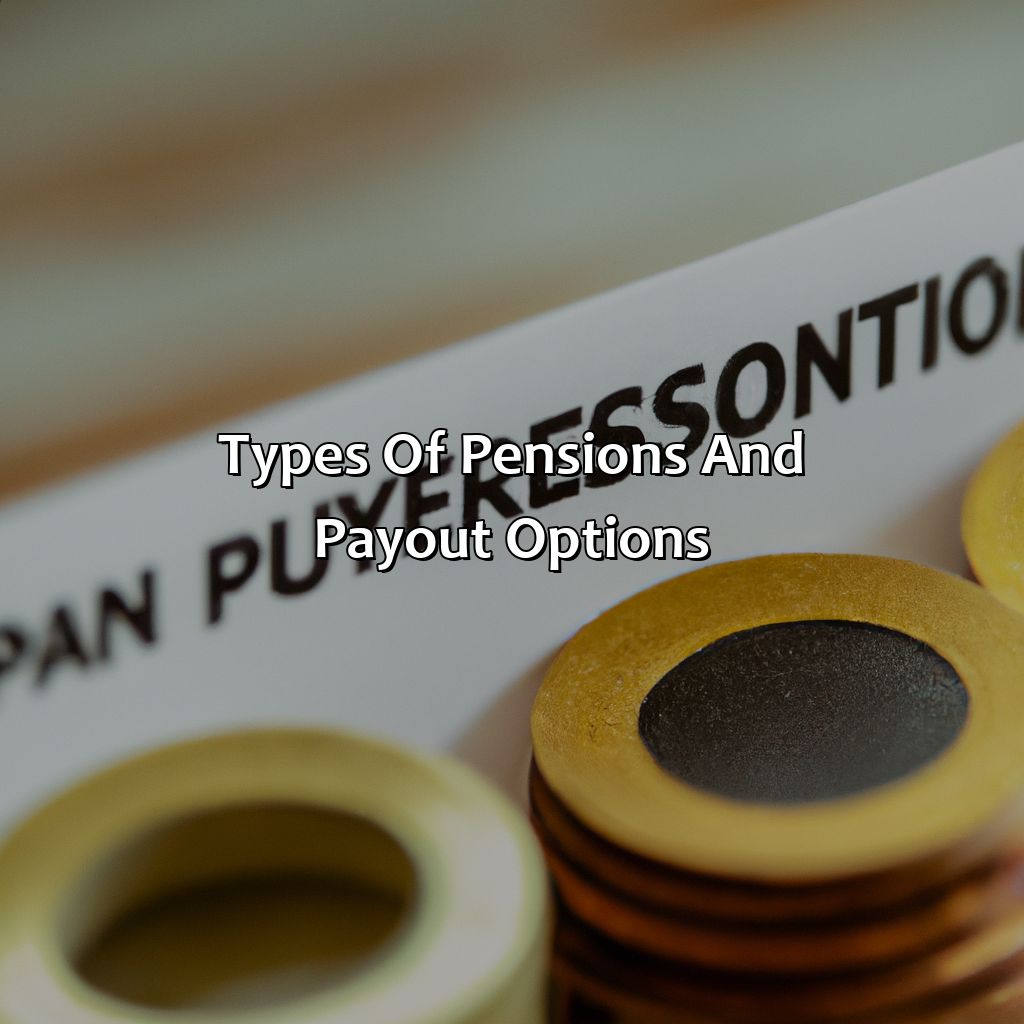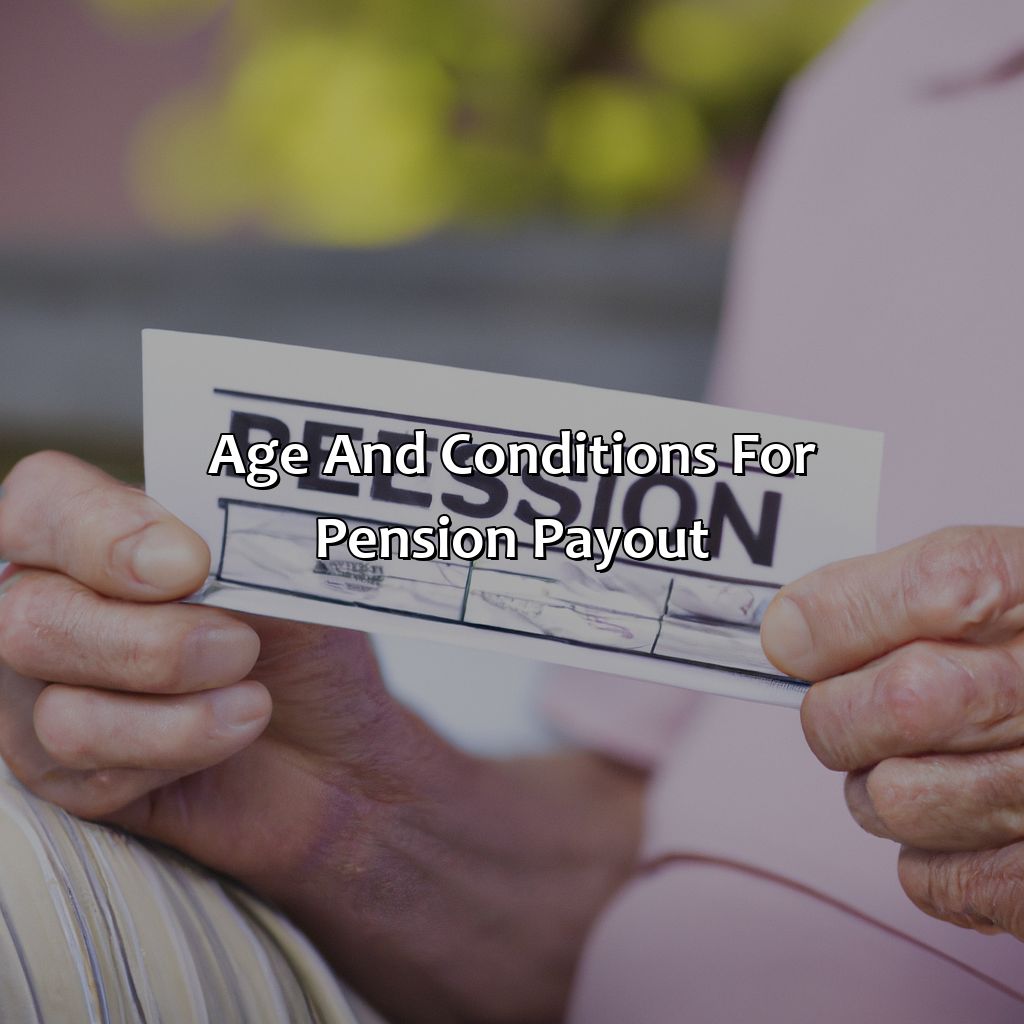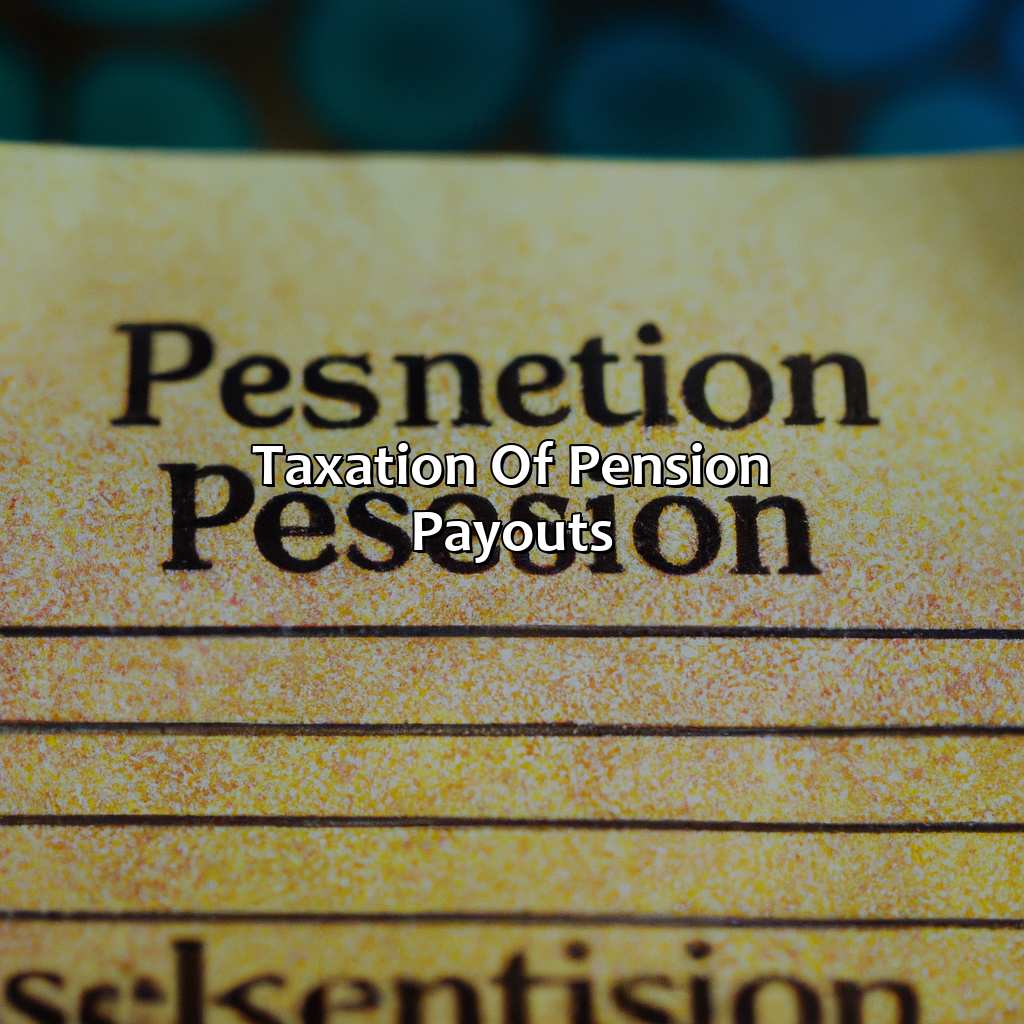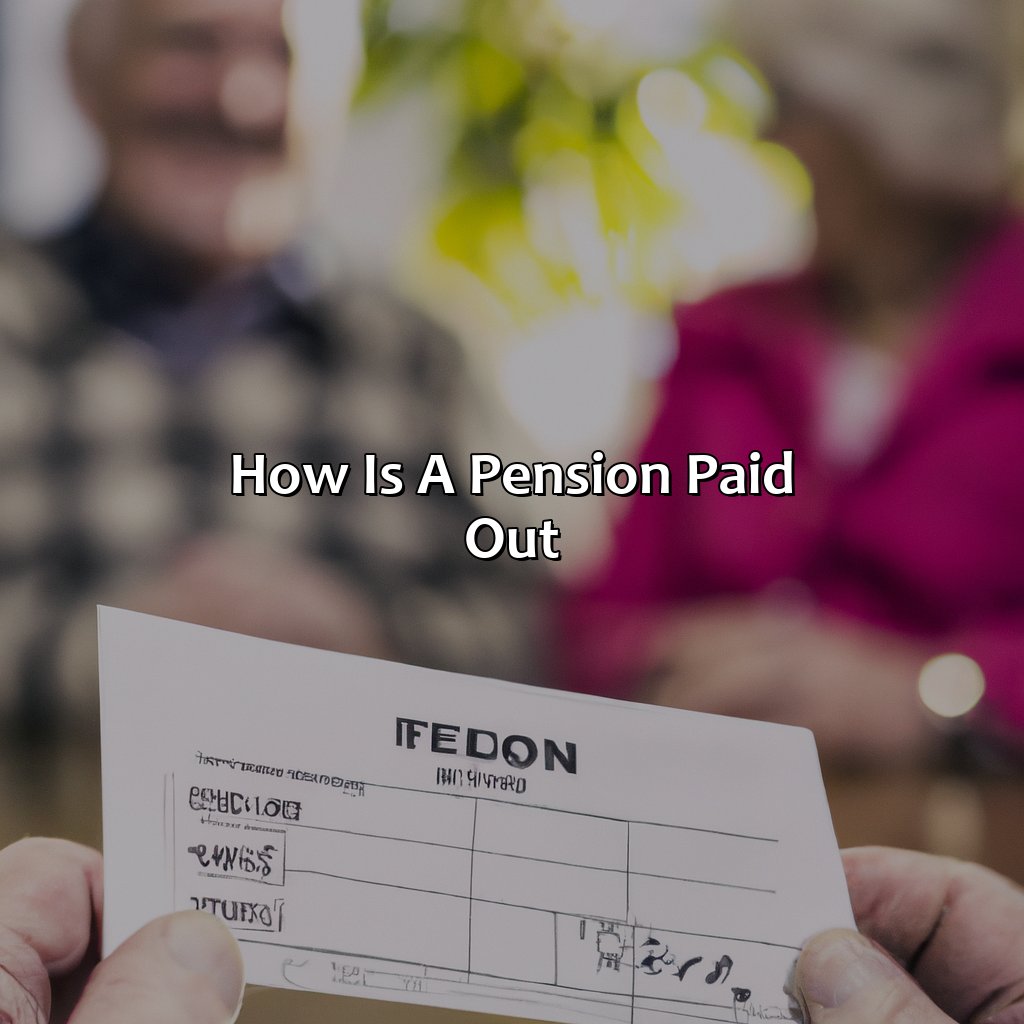How Is A Pension Paid Out?
Key Takeaway:
- There are two main types of pensions: defined benefit and defined contribution. Defined benefit pensions provide a fixed payout amount based on salary and years of service, while defined contribution pensions depend on contributions made and investment performance.
- Payout options for defined benefit pensions include lump sum payments or annuity payments, which provide a steady stream of income for life. Defined contribution pensions typically offer several payout options, including lump sum or installment payments, or the option to purchase an annuity.
- The age and conditions for pension payout vary depending on the type of pension and the specific plan. Generally, defined benefit pensions have minimum age requirements and may have health or employment status conditions. Defined contribution pensions typically have fewer restrictions and allow for more flexibility in when to begin receiving payouts.
- Taxation of pension payouts depends on the type of pension and the payout option chosen. Lump sum payouts are typically subject to higher tax rates, while annuity payments may be taxed at a lower rate. Taxation also varies based on the recipient’s age and income.
- To receive and manage pension payments, it is important to choose a reliable financial advisor who can help navigate the complex world of pensions and retirement planning. Long-term financial security can be achieved through careful management and planning of pension payouts.
Do you want to understand how pensions are paid out? This article will discuss the process and provide you with helpful information. Whether you are saving for retirement or in the process of taking your pension, understanding the payment structures can give you peace of mind.
Types of Pensions and Payout Options
To comprehend your pension payout, you must be aware of the two major types of pensions. These are ‘Defined Benefit’ and ‘Defined Contribution’ pensions. We will now focus on the payout options of each. This will give you a greater understanding of your pension plan and how your payouts will work, depending on what you pick.

Image credits: retiregenz.com by Joel Washington
Defined Benefit Pensions
Pensions that provide a benefit of known value to an employee or beneficiary are commonly referred to as Guaranteed Pensions. Defined Benefit Plans often have a formulaic payout structure based on variables such as the years of service and age at retirement. Employers fund these pensions with a guarantee of income for life, regardless of external factors such as investment returns and market fluctuations.
These pension plans may also offer various payout options, including lump-sum payments and annuities. Annuities provide guaranteed payments over time and help to ensure long-term financial security for retirees by providing a regular source of income. However, in some cases, the potential loss of accumulated pension benefits may need to be weighed against immediate cash needs when evaluating an option to claim civil service pensions.
Moreover, in some cases, employers may offer additional plan features for defined benefit plans such as early retirement or survivor benefits which will affect the payout amounts if selected. Retirees should consult with financial advisors before making significant decisions regarding their pension plan to understand all available options. To understand how a pension fund works, it’s important to know about these plan features.
Finally, clear communication between employers and employees regarding time frames for enrollment and payouts is essential in maintaining an organized pension plan. Making it easy for employees to select and adjust their pension options through digital apps or online portals can enhance satisfaction levels among those enrolled in defined benefit plans. Learn more about who manages pension funds and the payout process.
Saving for retirement is like playing a game of chance, but with defined contribution pensions you at least have some control over the odds.
Defined Contribution Pensions
Enhance your knowledge on pensions and payouts by delving deeper into ‘Retirement Investment Accounts’. These are defined contribution pensions where employees allocate funds into a retirement account, with the employer matching the contributions. The amount of payout entirely depends on the amount of investments made by both parties.
Subsequent to the retirement, depending upon a retiree’s spending needs of money and lifestyle requirements, they can opt for various ways of payout options which include:
- withdrawal as lump sum
- installment payout
- fixed annuity
It’s crucial to note that when it comes to Defined Contribution Pensions, having awareness about what you’re contributing is vital. So make sure to plan for Retirement now because time will pass irrespective of whether you act now or not, procrastination will only cost you more later!
If only choosing a payout option for your pension was as exciting as choosing toppings for your pizza.
Payout Options for Defined Benefit Pensions
Defined Benefit Pension Plans have different options for payout that offer flexibility and benefit to pensioners. Below is a breakdown of the options available.
| Option | Description |
| Lump Sum Payment | A one-time payment of the total pension amount or a portion thereof. |
| Life Annuity | A monthly fixed payment for life with no death benefits. |
| Joint and Survivor Annuity | A monthly fixed payment for life that continues to pay out to a named beneficiary after the pensioners’ death. |
In addition to these options, some plans may also offer an increased benefit option, which provides higher payments during the first years of retirement that decrease over time. It’s important to understand all available payout options before deciding on a plan.
Interestingly, Defined Benefit Pensions originated in the late 1800s as a way for employers to provide their employees with retirement benefits. These plans have since evolved into complex structures with various payout options available.
If only choosing between avocado toast and a pension payout option was as easy as choosing between Netflix and chill.
Payout Options for Defined Contribution Pensions
Defined Contribution Pension Payouts:
A range of payout options exist for defined contribution pensions. These payout options include annuities, income drawdown and lump sum payments.
Payout Options for Defined Contribution Pensions:
The following table displays the different payout options available for defined contribution pensions, highlighting the pros and cons of each option:
| Option | Pros | Cons |
|---|---|---|
| Annuities | Provides a guaranteed income for life | Fixed payments and limited flexibility |
| Income Drawdown | Flexibility to withdraw funds as needed | Risk of outliving savings if withdrawals are too high |
| Lump Sum Payments | Access to entire pension pot at once | Limited regular income |
Other Considerations:
When choosing a payout option, factors like age, retirement goals, tax implications and financial situation should also be considered.
Pro Tip: Seeking professional advice can help individuals choose the best payout option based on their unique circumstances.
Finally, something to look forward to in old age – the sweet release of a pension payout.
Age and Conditions for Pension Payout
Discover when and how to get your pension payment. Explore the ‘Age and Conditions for Pension Payout’.
This has two sub-sections:
- ‘Age Requirements’
- ‘Health Conditions’, and ‘Employment Status’
These provide details of who qualifies and what affects payments.

Image credits: retiregenz.com by Joel Duncun
Age Requirements
The eligibility to receive pension payouts is subject to certain age criteria. The minimum age to be eligible for a pension payout varies by country, ranging from 55 to 65 years. Additionally, the age at which retirees can receive full benefits may vary based on factors such as years of service or specific job requirements.
Furthermore, certain conditions need to be met in addition to reaching the minimum age requirement. For example, in some countries, individuals must have contributed a certain amount of funds into a pension scheme over a specific period of time. Others may require that individuals be retired before they can qualify for pensions.
It’s important to note that each pension scheme may have different requirements for eligibility and payout amounts. Some plans also offer early retirement options with reduced benefits. If you’re wondering which of the following IRAs provides a pension for employees, visit our website to learn more.
If one does not meet these requirements, there may be the possibility of missing out on receiving valuable pension payouts later in life. Therefore, it is essential to understand the specific eligibility and payout criteria in order to plan for a comfortable retirement. Wondering how to check your pension? Learn more here.
Aging gracefully is a myth, because let’s face it, the only thing graceful about old age is how quickly it goes downhill.
Health Conditions
Maintaining good health conditions is crucial for receiving a smooth pension payout. Insurance companies often require a medical examination before approving the payment process. For critical or terminal illnesses that leave little chance of recovery, advanced payouts can often be claimed. These unique cases vary on a company-by-company basis and must be explored beforehand.
According to the CDC, 60% of Americans have one chronic illness, and 40% have two or more. Therefore it’s highly advised to invest in preventative healthcare measures early on to avoid being denied any pension benefits due to poor health.
Employment status may affect your pension payout, but if you’re still working at 70, you’re either a workaholic or living in denial about retirement.
Employment Status
When determining the eligibility for pension payout, one crucial factor to consider is the individual’s occupational status. Whether the person is employed or self-employed will significantly affect their payout. As an individual who is employed, a percentage of their salary would have been deducted as a contribution towards their pension scheme. However, for someone who is self-employed, they may have to manage and contribute to their scheme privately.
Additionally, retirement age should be considered as it directly affects when the pension payouts start. Most people retire between the ages of 60 and 65, which often correlates with when pension schemes offer payouts. However, certain occupations allow people to retire early and still receive their full benefits depending on the years worked. If you are wondering how to find out your pension, RetireGenz provides helpful resources to help you navigate the process.
It’s worth noting that different companies or countries have various pension schemes that determine how much a person receives during payout. For instance, in Germany, employees under mandatory statutory pensions receive payouts based on what they contributed throughout their working life.
According to Pension Rights Center (PRC), in 2020, only about 23% of the US working-age population participated in defined benefit plans offered by employers.
Looks like the only thing certain in life besides death and taxes is the taxation of your pension payout.
Taxation of Pension Payouts
Uncover the details of pension taxation! Investigate the subsections. These include: taxes on payout choices and taxes based on age and money. This will give you a complete understanding of how your pension is taxed and what approaches are available for controlling your tax burden.

Image credits: retiregenz.com by Harry Arnold
Taxes on Different Payout Options
When it comes to receiving pension payouts, taxes play an important role in determining the amount received by the recipient. Various options are available for receiving pensions, and each is subject to different tax rules which affect the total payout amount.
Below is a table showing taxes on different pension payout options:
| Payout Option | Tax Treatment |
|---|---|
| Lump Sum Payment | Subject to income tax at the individual’s marginal tax rate |
| Regular Pension Payments | Taxable as regular income, subject to withholding |
| Joint-and-Survivor Annuities | Taxable as regular income, subject to withholding but with a lower tax rate |
It’s important to note that taxes are calculated differently based on specific factors such as age, eligibility criteria and country norms.
Aside from these factors, it’s imperative to consider social security benefits on any additional taxable funds. This requires careful planning and professional advice before committing to a specific payout option.
For instance, John received his annual pension payment of $50k with 10% federal withholding of $5k in taxes deducted. His spouse Mary passed away last year; thus he would prefer now switching from single life-only option and moves onto another plan with more returns considering his situation.
To sum up, understanding the intricate details of taxation on various pension payout options can be challenging but essential for making informed financial decisions that benefit us in the long run. Consultation with a trusted financial advisor can prove helpful in maximizing our retirement income while minimizing unnecessary tax liabilities. If you are wondering about the asset test for the aged pension, do check out this helpful article.
Aging may bring wisdom, but it also brings taxes – and the higher the income, the faster the gray hairs multiply.
Taxation Based on Age and Income
If we consider taxation of pensions based on age and income, then there are a few rules that need to be understood. These rules vary depending on the country, state/region and organization where the individual works or draws their pension from. Below is a table that highlights some general information about how pensions are taxed based on an individual’s age and income.
| Age | Income | Taxation |
|---|---|---|
| Under 50 | Lower bracket | Regular tax rate |
| Under 50 | Higher bracket | Additional taxes, including penalty tax |
| Over 50 | Lower bracket | Regular tax rate with minor benefits |
| Over 50 | Higher bracket | Slightly reduced tax rate with more significant benefits |
It’s essential to remember that these are general guidelines, and each individual case may have its unique set of circumstances that can impact the taxation amount. It’s always advisable to seek financial advice and consult relevant authorities before making any decisions regarding pensions. Furthermore, it’s worth noting that some countries offer further benefits to individuals who continue to work past their retirement age. In such cases, they may receive additional tax credits or other incentives to keep working; this can help reduce the burden of taxes on pensions. With so much variation in rules related to pension payouts and taxation, it’s easy for individuals to miss out on opportunities for financial savings or overload with excessive taxes. Therefore, seeking professional guidance can be highly beneficial in ensuring maximum benefits while minimizing losses. Don’t miss out! Seek expert advice today and ensure you make informed decisions! Managing your pension payments is like playing a game of chess, except you can’t cheat by hiding your money under the board.
How to Receive and Manage Pension Payments
You need the right approach to receive and manage pension payments effectively. One solution is to select a lump sum payment. Another is to choose an annuity payment. Furthermore, selecting a trustworthy financial advisor is important. To ensure long-term financial security, you must manage your pension payments. These sub-sections will assist you in comprehending the process and making decisions about your pension payments wisely.

Image credits: retiregenz.com by Adam Washington
Lump Sum Payments
A lump sum payment is a one-time payment received from a pension plan after an individual retires or leaves a job. This payment option allows for the entire amount of the earned benefit to be paid out at once instead of receiving monthly payments.
To receive a lump sum payment, individuals typically need to apply for it through their pension plan provider and select this option during the retirement process. The amount received will depend on various factors such as age, years of service, and overall contributions made into the plan.
It’s important to note that choosing this payment option can have tax implications and could potentially result in a higher tax rate than receiving monthly payments. It’s essential to consult with a financial advisor before making any decisions about how to receive pension payments.
In order not to miss out on any potential benefits or drawbacks of this payment option, it’s vital to carefully research and consider all available options before deciding how to manage your pension income. How do I find my pension information? Consultation with experts can prevent any long-term financial challenges that may arise from unplanned methods of handling your retirement funds.
Annuity payments: the gift that keeps on giving you enough money to buy a cup of tea and a biscuit every month.
Annuity Payments
When it comes to periodic payments received as a series of fixed annuities, it’s important to understand how they are structured and distributed. An annuity payment is the regular stream of income one receives after making contributions to an insurance or pension plan, either in a lump sum or incremental payments.
This payment model offers significant advantages like steady retirement income flow and tax-deferred growth. But as per the terms of the agreement, you give up your investment and allocate your wealth to the insurer who pays interest while protecting your funds from market instability. These rights cannot be reversed.
In addition, you have several choices such as receiving lower monthly payments for life, opting for higher payouts but with specific end dates or choosing joint survivor options that allow surviving spouses to collect continuing payouts if a recipient passes away.
Once you receive your savings plan funds as annuity payouts, taxation factors change because annuity payout taxation falls under two categories: partial return of capital contributions tax-free and investment returns taxed at ordinary urban rates when distributed.
For instance, Jane who retired recently opted for guaranteed annuity payouts alongside Social Security. She decided on getting 10% distribution annually without principal return. This way, she earned $54K a year with prior taxes paid out upfront so that future gains could be well-managed.
Your financial advisor should be as reliable as your best friend, but with better investment tips and less drama.
Choosing a Reliable Financial Advisor
When seeking investment guidance, it is important to find a trustworthy and knowledgeable financial professional. Securing a Reliable Financial Advisor, who has a track record of sound decision-making, can set one on the path to achieving long-term goals. They help manage money by offering impartial advice and tailored solutions.
A financial advisor could help in managing investment portfolios, planning retirement income streams or giving estate planning advice. They may also offer services around tax-planning strategies, providing valuable insights into the market changes that impact individual portfolios. Working with a trusted advisor is essential for anyone hoping to secure their financial future.
While choosing an advisor, reviews of their experience, qualifications and education are critical considerations. Some may be dedicated to ensuring customers’ investments meet certain ethical or social standards. Finding someone who shares similar investment beliefs can help you trust their investment recommendations and feel confident with your choices.
It’s vital to remember that every person’s needs are unique; therefore, there is no standard solution for everyone s situation. The process of selecting an advisor requires suitable research and discernment as choosing the wrong one could have dire consequences such as insufficient funding later in life.
When looking for expert advice about Retirement Planning or Investment Management requires careful planning; some trustworthy tools include referrals from Trusted Co-workers, Financial Institutions like banks or Credit Unions that provide asset-management expertise. Choosing an Oath-Bound financial Partner provides comfort knowing they care about your funds like theirs.
Managing Pension Payments for Long-term Financial Security.
Managing pension payments can ensure long-term financial security for retirees. To receive pension payments, one needs to set up a payment plan that suits their lifestyle and financial goals. Choosing how the pension is paid out, such as lump sum or regular payments, can affect taxes and income stability. Understanding these options and making informed decisions can guarantee a comfortable retirement.
By selecting the right pension plan and payment option, retirees can secure their financial future while ensuring their day-to-day needs are covered. For example, many retirees opt for regular payments to manage expenses better, while others prefer lump-sum payouts to cover large expenses upfront. It’s essential to consider individual circumstances when managing pension payments for long-term security. Check out how many pension plans are there in the US to make an informed decision about your retirement plan.
Retirees should also be aware of any changes in tax regulations or market conditions that might affect their pension income. Monitoring cash flow and adjusting payment plans accordingly can alleviate financial stress in unexpected situations. By staying informed and taking proactive measures, individuals can feel confident about managing their pensions for long-term financial security.
Don’t miss out on securing your future through effective management of pension payments. Seek the advice of professionals and stay up-to-date with changing regulations to make informed decisions about your finances. With the right guidance and strategic planning, you can protect yourself against unexpected events while leading an enjoyable retirement free from monetary stress.
Five Facts About How a Pension is Paid Out:
- ✅ A pension is typically paid out in regular intervals, such as monthly or quarterly. (Source: Investopedia)
- ✅ The amount of a pension payout is determined by factors such as length of service, salary, and age at retirement. (Source: Pensions and Investments)
- ✅ Pensions can be paid out as lump sum distributions or in annuity payments over a period of time. (Source: The Balance)
- ✅ Pension payments are often subject to taxes, but the amount depends on the type of pension plan and the recipient’s tax situation. (Source: The Motley Fool)
- ✅ It’s important to plan ahead and consider factors such as inflation and life expectancy when deciding how to take pension payouts. (Source: Forbes)
FAQs about How Is A Pension Paid Out?
How is a pension paid out?
A pension is paid out to the retiree in various forms. The common forms in which a pension plan is paid out include annuities, lump sum payment, or a combination of both.
What is an annuity?
An annuity is a form of pension payment that is spread over a period. The payments are made at specific intervals, usually monthly, and they continue for the rest of the retiree’s life. An annuity payment is a fixed amount, and it is calculated based on the retiree’s life expectancy and the amount of money available in the pension plan.
What is a lump sum payment?
A lump sum payment is a one-time payment that is made to the retiree. The amount is calculated based on the value of the pension plan and the retiree’s age and life expectancy. The retiree can choose to take the lump sum payment in a single go or spread it over a period.
Can I choose how my pension is paid out?
Yes, you can choose how your pension is paid out. Many pension plans offer retirees several options for receiving their benefits, such as annuities, lump sum payment, or a combination of both. Discuss your options with your pension provider ahead of time to make a sound decision.
Is it possible to transfer a pension to a new provider?
Yes, it is possible to transfer a pension to a new provider. However, not every pension scheme permits this. The new provider could be another employer or a personal pension plan. You need to speak to your pension provider to find out how to transfer your pension to a new provider.
What happens to my pension if I die?
If you die before your pension payments commence, your beneficiaries may be able to receive the value of your pension plan, depending on the specific plan’s terms and conditions. If you die after starting to receive the pension, the payments will continue to your spouse or beneficiary depending on the terms and conditions of the plan.
